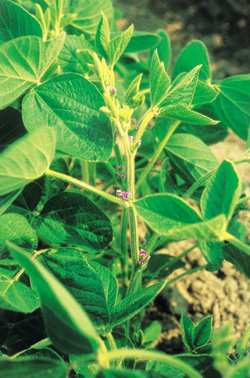
Features
Agronomy
Irrigation
Ground manoeuvres
Applying fungicide or insecticide by ground has some advantages over aerial application.
November 14, 2007 By Top Crop Manager
 On the thousands of acres of potatoes grown in Canada, eliminating fungicide
On the thousands of acres of potatoes grown in Canada, eliminating fungicide
application is not an option. While in many parts of the country, fungicides
can only be applied by ground sprayers due to the size of fields and hazards
that hamper aerial application, in western Canada, potato growers can choose
between the two. While many growers use a combination of ground and aerial application,
there are some advantages to ground only application that may get overlooked.
The size of any potato operation and other factors, such as whether the fields
are irrigated, make the choice of spray operation a management decision one
that needs to be made carefully. Issues are raised around compaction of the
soil in wheel tracks left by heavy, high clearance sprayers that might reduce
yield and make harvest might challenging. These are not issues that affect everyone,
says a potato agronomist with a large crop supply outlet in Portage la Prairie.
"A lot depends on the soil type where the potatoes are being grown,"
says Taralea Simpson of Munroe Farm Supplies, a company that also offers custom
ground application. "If potatoes are grown on heavy clay, compaction can
be a huge issue because it will pack down and cause many problems. However,
some of my growing area includes soil we call almassippi sand and it does not
present the compaction problems of the heavier soil."
It is difficult to portray one method of application as better than the other,
Simpson continues, because both offer benefits and she tries to help her customers
choose the best method for their operation. "Without a doubt, ground spraying
offers a better view of the field and growers who do their own ground spraying
have an opportunity to see their crop 'up close' on a regular basis and they
can assess pest problems better," she explains. "I think that ground
application puts more water on the crop which can give better coverage and,
as an agronomist, I do believe that higher water volume is good."
A grower who uses both types of application on his potato crop says he can
see benefits with both. Stan Wiebe, who operates Beaver Creek Farms in partnership
with his brother, Don, near MacGregor, Manitoba, says he knows compaction by
the sprayer wheels loses them about one percent in yield. However, they will
do up to four fungicide applications by ground at the beginning of the season
while the crop is getting started and then will switch to aerial application.
It is as much about time constraints to get all the spraying done as it is a
conscious decision to reduce compaction. Most of Beaver Creek Farms is almassippi
soil and Wiebe adds that he has observed damage to the root system of plants
due to compaction, which affects yield, even if the soil is not as prone to
clumping and heavier compaction observed on clay soils.
"We choose between air and ground depending on the need and situation.
The early application of herbicides needs to be done by ground, but with fungicides
and insecticides, we lean towards aerial application as our preferred method,"
Wiebe says. "We have irrigation on our operation and it is easier to schedule
air application around that than ground application because of the time involved.
A well-calibrated ground unit with a good operator is an equal option to a well-calibrated
aerial unit with a good operator, but it would still have to fit into a farming
schedule and situation."
"Nozzle calibration is very important," adds Simpson. "Our company
checks our equipment regularly and monitors our nozzles. We can't afford to
have misses in the field." She says there may also be an issue with width
of the sprayer tracks in comparison to the planter tracks, but it is likely
minor.
"With costs being similar to have either custom air or ground application,
it will always come down to what meets a grower's needs," adds Simpson.
"It might be a time constraint issue. In 2006, we had hot weather and the
irrigation was running constantly, so air application of fungicides worked better."
Simpson says growers need to look at both options, examining the pros and cons,
and then decide what is most feasible for their operation. "There is a
small yield loss with ground, but you get more water volume and possibly better
coverage," says Simpson. "However, I don't think most growers do detailed
analyses of the losses or comparisons of costs and effectiveness of each application
method. Generally, growers base their decisions on what fits into their schedule.
Nevertheless, if there is a need to improve the bottom line, it might be worth
the effort to do a cost comparison and an examination of effectiveness of the
chosen method."
While many growers do use air application because of its speed, most still
will not be without a ground application unit or access to one. If nothing else,
ground application is always available if weather circumstances keep the planes
on the ground. -30-